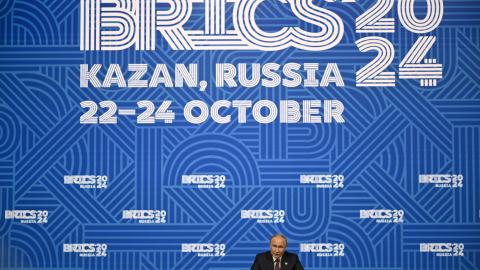The BRICS group — named after its five founding members, Brazil, Russia, India, China and South Africa — has become a broader grouping of non-Western countries that wants to stay out of growing U.S.-China competition and hopes to reset the world order. The inclusion of the United Arab Emirates, Egypt, Ethiopia and Iran in the 16th BRICS Summit in Russia last week formally marked the group’s expansion.
BRICS started in 2009 as a forum for cooperation among the world’s five largest emerging economies. But by 2024, it is trying to convert itself into an effective voice for the Global South, seeking economic opportunities many countries feel the West denies them.
Instead of seeing BRICS as another indication of China’s growing influence, American policymakers could recalibrate global engagement to consider the reasons, and sentiment, that have inspired such a shift away from the West.
The three Middle Eastern countries that have joined BRICS, for instance, are not just seeking a shift away from the West. Their decision is more likely a part of the continuing process of economic, diplomatic and security diversification being pursued by countries of the Middle East and Asia. The UAE joined India as a “Major Defense Partner” of the U.S. just last month, affirming its desire to remain close to America while adjusting to an increasingly multipolar and multi-aligned world.
Saudi Arabia and Argentina were also invited to join BRICS in August 2023. Saudi Arabia participated in this year’s summit as a guest without formally joining the bloc, but Argentina declined the invitation soon after it was issued. Clearly, not all countries see the economic grouping as a “must join” club.
The 2023 expansion of BRICS was the first since South Africa joined the other original members in 2010. The enlargement from a list of 22 aspiring applicants has revitalized the grouping after years of skepticism about its importance and impact. BRICS-plus now represents 46 percent of the world’s population and 36 percent of its GDP in terms of purchasing power parity.
The expansion also facilitates the reinvention of BRICS, which attempted to carve an alternative political world order through economic channels. Few observers give BRICS 1.0 much credit, but it introduced alternatives to the Bretton Woods Development Financial Institutions by creating the Asian Infrastructure Investment Bank. In its new avatar, the focus of BRICS is likely to be on economic issues, which could make it more impactful, despite the political differences among its members — especially between China and India.
Emerging-market economies are urging more representation for the Global South in world affairs, which suits the interests of the expanded bloc. Joining it adds great value for smaller countries like the UAE, which is positioning itself as a middle power because of its agency through several Cs: crude oil, capital, commerce, collaboration, cyber technology, climate, connectivity, competition and compromise.
As explained by UAE Foreign Minister Sheikh Abdullah bin Zayed Al Nahyan, the UAE joining BRICS is part of the country’s “focus on long-term economic prosperity and maintaining balanced strategic and economic relations…in an ever-evolving world order.”
Some Western media commentary aside, none of the BRICS leaders want the grouping to be viewed as a challenge to the U.S. or the West. The last summit host, South Africa, had stressed that BRICS was “inclusive” and not “anti-West.” Brazil endorsed this by stressing that the bloc’s new members were chosen for their geopolitical importance and not for ideology.
Days ahead of the summit, Russian President Vladimir Putin asserted that the grouping is not “anti-West,” but is just “non-West,” recalling that India too had underlined this formulation. BRICS 2.0 has set aside ideology, invited 24 countries for the summit in Russia, and offered smaller countries a seat at the high table. The U.S. too might benefit from looking beyond the G7, which has so far been an exclusive club of leading post-World War II democracies, whose economies thrived until the turn of the century but are now slowing down.
The BRICS-plus bloc, which now has at least a half-dozen G20 members, is also discussing a common currency. Though this is unlikely to materialize any time soon, some of the BRICS-plus members have already started using their local currencies to conduct trade. In August 2023, the UAE and India began settling bilateral deals, including crude oil transactions, using their local currencies instead of the U.S. dollar.
A few months earlier, the UAE and China made their first-ever purchase of liquified natural gas in yuan. While these could be politically read as potential de-dollarization moves that help bypass U.S.-imposed sanctions, financial experts have stressed that such currency switches and diversification help simplify business dealings and reduce currency conversion fees.
Although the expansion of BRICS signals the desire of many middle powers to find a way forward without being bound by inconsistent policies formulated in Washington, National Security Adviser Jake Sullivan says the U.S. is not anticipating the BRICS grouping evolving into a “geopolitical rival to the United States.” But understanding the concerns that are prompting countries to join a non-West grouping like BRICS should be part of America’s plans for engagement with these emerging economies.
Read this article, co-written with Narayanappa Janardhan, in The Hill.
Enjoyed this article? Subscribe to Hudson’s newsletters to stay up to date with our latest content.















